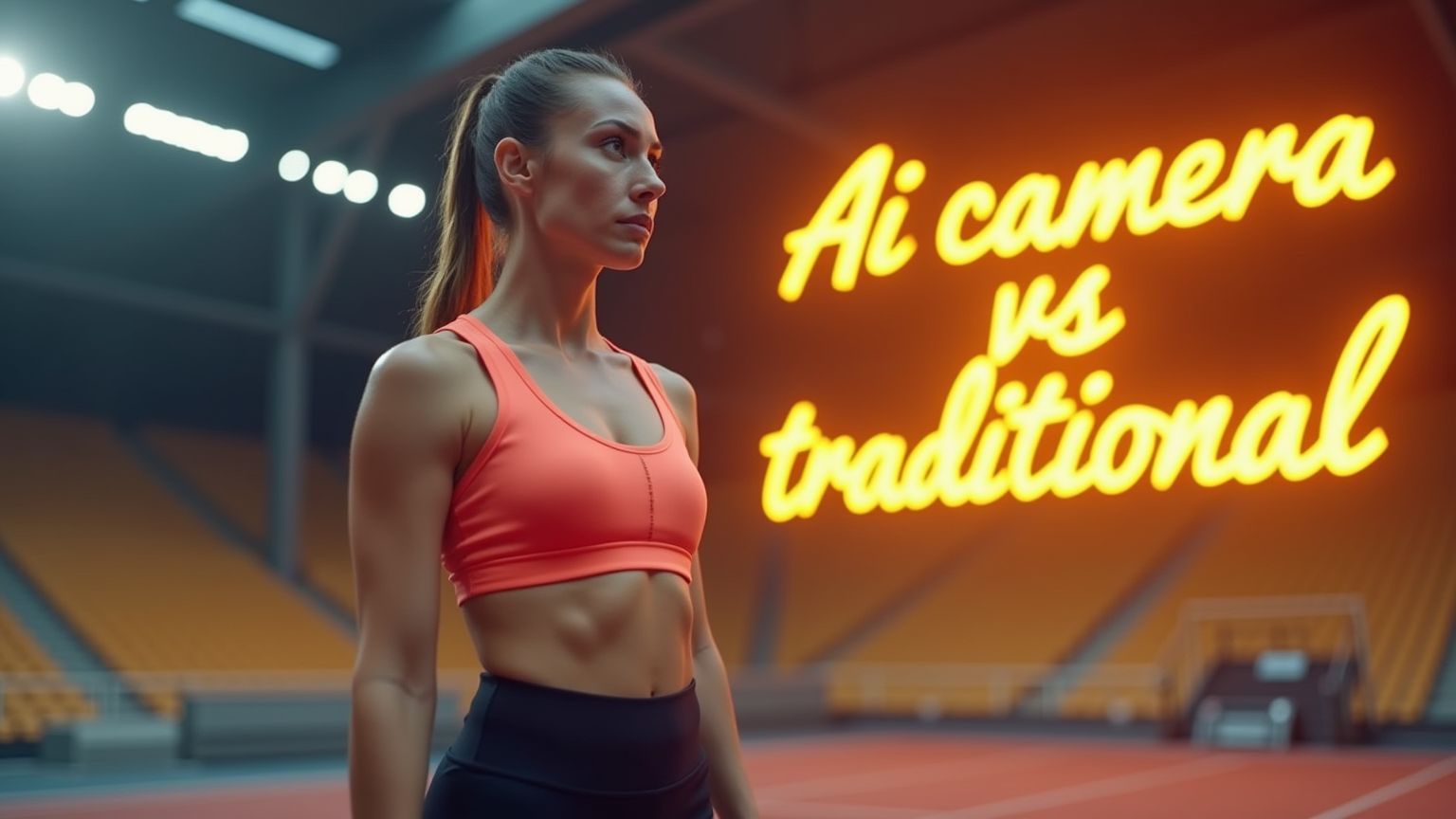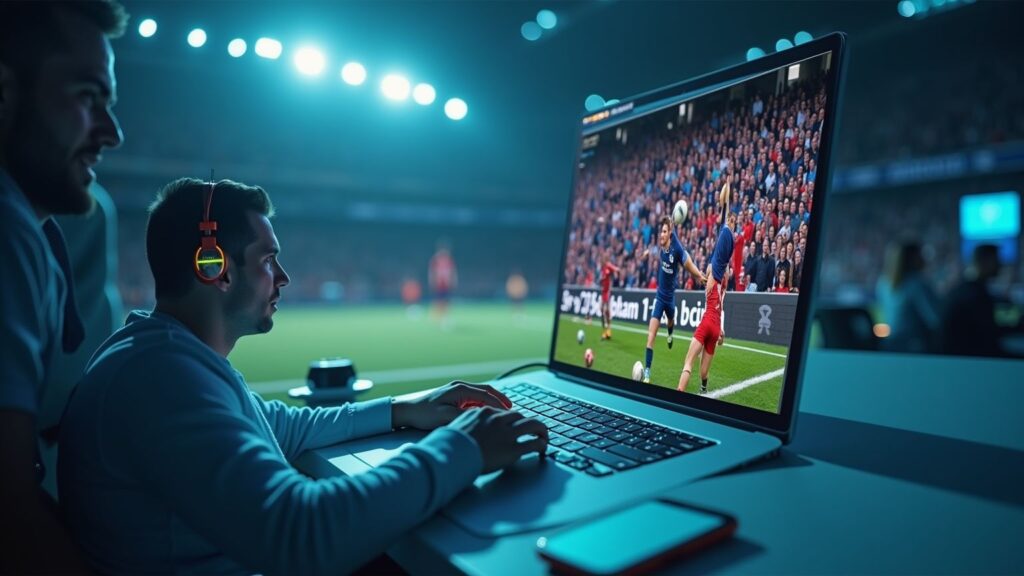AI Sports Tracking Camera vs Traditional Systems: Powerful Game Analysis
Imagine never having to manually follow the action during a game again. Whether you’re a coach analyzing player movement, a…

Imagine never having to manually follow the action during a game again. Whether you’re a coach analyzing player movement, a fan enjoying seamless footage, or a broadcaster looking for dynamic coverage, AI sports tracking cameras are changing the way sports are recorded and experienced.
These smart cameras use artificial intelligence to automatically follow the ball, track players, and generate real-time data. Unlike traditional cameras, which rely on manual control, AI sports tracking cameras provide a hands-free experience that ensures no key play is missed.
The technology helps reduce human error, improve efficiency, and enhance the overall viewing experience.
In this article, we’ll compare AI sports tracking camera vs traditional camera systems to help you understand the advantages and trade-offs of each. You’ll learn about key features like automated player tracking, video analytics, and enhanced user experience. We’ll also examine the costs involved—both upfront and long-term—to determine which system offers the best value.
Whether you’re a sports organization, a coach, or a content creator, making the right choice of sports camera technology is crucial. Let’s break down everything you need to know to make the best decision for your needs.
AI Sports Tracking Camera Features

Automated Player Tracking
Imagine capturing every play, every move, and every moment of a game—without ever manually adjusting a camera. That’s the power of automated player tracking. With AI-driven sports tracking cameras, the days of needing a dedicated camera operator are over. These smart systems use advanced computer vision and machine learning to follow players in real-time, ensuring the action stays in focus.
This technology works by identifying and tracking player movements on the field or court. The AI detects patterns, recognizes players, and adapts its framing automatically. Whether it’s a soccer striker sprinting toward the goal or a basketball player making a fast break, the camera smoothly follows the motion, delivering a seamless viewing experience.
Here’s why automated tracking makes a difference:
By eliminating human error and enhancing coverage, AI-powered sports cameras make professional-level broadcasting accessible to everyone. Whether you’re a coach analyzing plays or a fan watching the game, automated player tracking ensures you never miss the action.
Real-Time Analytics
Imagine watching a game where every play, every movement, and every performance detail is instantly analyzed and displayed—it’s like having a coach, commentator, and statistician all rolled into one. That’s exactly what AI-powered sports tracking cameras offer with real-time analytics. These systems go beyond simple video recording, using artificial intelligence to process data as the action unfolds.
With real-time analytics, you get instant insights into player speed, positioning, shot accuracy, and more. Coaches can make split-second decisions based on live data, helping teams adjust their strategies mid-game. Players benefit too, as they receive immediate feedback on their performance, allowing them to fine-tune their techniques in real time.
The advantages extend to fans and broadcasters as well. Imagine watching a live stream where key stats, player heat maps, and advanced metrics are seamlessly overlaid on the screen. This level of detail enhances the viewing experience, making games more interactive and engaging.
Whether you’re a coach looking to refine strategy, a player wanting to improve, or a fan craving deeper insights, real-time analytics bridge the gap between raw footage and actionable knowledge. AI-powered cameras aren’t just recording the game—they’re redefining how we see and understand sports.
Enhanced User Experience
When you’re watching or analyzing a game, you want the best possible viewing experience. AI-powered sports tracking cameras take this to the next level by enhancing accessibility, engagement, and control for users. Whether you’re a coach, player, or fan, these smart cameras offer features that traditional systems simply can’t match.
One major advantage is the hands-free operation. With AI-driven technology, there’s no need for a camera operator to manually follow the action. The system intelligently tracks players and the ball in real-time, ensuring you never miss a key moment. This means smoother footage, fewer errors, and a more immersive experience.
Another game-changing benefit is instant replay and customizable viewing angles. AI cameras allow users to review highlights immediately, adjusting angles as needed. Coaches can break down plays from multiple perspectives, while fans can relive game-changing moments on demand.
Additionally, many AI sports cameras integrate seamlessly with mobile apps and cloud storage, allowing for easy sharing and analysis. Whether you’re live-streaming a match or reviewing footage for training, these systems provide a user-friendly experience tailored to modern needs.
Ultimately, AI-powered cameras aren’t just about capturing games—they’re about transforming how you interact with sports. They make viewing and analyzing games more intuitive, efficient, and interactive than ever before.
Traditional Camera Systems
Manual Operation
If you’ve ever operated a traditional sports camera, you know how much effort goes into capturing the perfect shot. Unlike AI-powered sports tracking cameras, which follow players autonomously, traditional camera systems rely entirely on human control. This means a trained camera operator must manually pan, zoom, and adjust angles throughout the game.
Because of this, filming with traditional cameras requires significant skill and experience. A single lapse in attention could mean missing a crucial goal, an incredible play, or an unexpected moment. Even with multiple operators and cameras, tracking fast-moving action in real time remains a challenge.
Manual operation also limits flexibility. Broadcasters, coaches, or analysts must decide in advance which angles they’ll prioritize, as adjusting on the fly isn’t always possible. This contrasts sharply with AI-driven systems, which can dynamically shift focus based on game activity.
While manual operation gives professionals full creative control, it’s also time-consuming. Post-game footage review often requires significant editing to compile useful highlights, whereas AI cameras can generate pre-clipped plays instantly.
Ultimately, traditional camera systems offer reliability but demand a high level of skill, effort, and attention. For organizations looking to streamline coverage and analysis, this manual process can pose a significant drawback compared to AI-driven alternatives.
Limited Analytics
When it comes to analyzing game performance, traditional camera systems have significant limitations. Unlike AI-powered sports tracking cameras, which provide instant data on player movement and team strategies, traditional cameras primarily capture raw footage without built-in analytical tools.
With conventional systems, you often need additional software or manual effort to break down the footage. Coaches and analysts must spend hours reviewing the video to extract crucial insights like player positioning, speed, and tactical patterns. This manual process is time-consuming and can lead to delayed decision-making.
Another drawback is the lack of real-time analytics. Traditional cameras simply record the action, requiring post-game analysis to gather performance insights. In contrast, AI sports tracking cameras generate live performance metrics, enabling coaches and players to make on-the-fly adjustments.
However, one advantage of traditional cameras is that they allow for full control over what is being recorded. Since AI-driven cameras focus on automation, they may sometimes miss key off-the-ball movements. Traditional cameras, when combined with skilled operators, can capture a broader view of the game, though at the cost of additional labor and post-production analysis.
Ultimately, for those looking for immediate, in-depth performance breakdowns, traditional systems fall short. While they serve their purpose in basic recording, they lack the advanced analytics now available with AI-powered alternatives.
Established Reliability
One of the biggest advantages of traditional camera systems is their proven reliability. These cameras have been used in sports broadcasting, coaching, and analysis for decades, meaning they come with a level of trust that AI-based cameras are still working to earn. Since they operate on manual controls, there’s little risk of unexpected software glitches or AI misinterpretations disrupting a recording or live stream.
With traditional systems, human operators ensure precise framing, focus, and movement tracking. Unlike AI cameras, which rely on algorithms to predict movement, manual control allows for on-the-spot decision-making, preventing moments from being lost due to tracking errors. This is particularly beneficial in unpredictable sports like soccer or basketball, where sudden shifts in play can confuse AI-based tracking.
Additionally, traditional cameras often have better compatibility with existing broadcasting setups. Many stadiums and sports facilities already have infrastructure designed around these systems, making integration seamless. This avoids the need for new training, software updates, or troubleshooting unfamiliar AI technology.
However, reliability comes with trade-offs. While traditional cameras consistently deliver clear footage, this consistency depends on skilled operators. Without them, manual systems can suffer from human error, and they generally lack the advanced analytics and automation that AI sports cameras provide.

AI sports tracking camera vs traditional – Comparing Cost and Efficiency
Initial Investment
If you’re considering AI-powered sports tracking cameras, the initial investment is likely one of your biggest concerns. After all, these high-tech systems come with a higher upfront cost than traditional camera setups. But what exactly are you paying for?
AI sports tracking cameras often require advanced hardware, including high-resolution lenses, AI-driven processors, and cloud-based storage solutions. Many also come with subscription fees for software updates and analytics, adding to the initial expense. On the other hand, traditional cameras have a lower entry cost since they rely on manual operation and don’t require complex processing units.
However, it’s important to look beyond just the price tag of the camera itself. Traditional systems may require additional expenses, such as hiring camera operators, investing in tripods or mounting equipment, and setting up more extensive infrastructure to capture the same level of detail AI cameras provide automatically.
In simple terms, AI sports tracking cameras demand a higher upfront cost but offer automation and advanced features that may offset long-term operational expenses. If you’re focused on efficiency and enhanced coverage, the initial investment can be well worth it. But if budget constraints are a top priority, a traditional setup might be a more cost-friendly starting point.
Long-Term Value
When investing in a sports tracking camera, it’s important to look beyond the initial cost and consider the long-term value it provides. AI-powered sports tracking cameras may seem like a larger investment upfront, but their efficiency and automation can lead to significant savings over time.
One major factor is reduced labor costs. Traditional camera systems require human operators to track the action, adjust angles, and manage recordings. With AI-driven cameras, these tasks are fully automated, which means fewer staff members are needed to operate the system. This is especially beneficial for schools, clubs, and smaller organizations that may not have the budget for a full production team.
Another key advantage is advanced data collection. AI cameras don’t just capture footage—they analyze plays, track player movements, and compile performance analytics. These insights can be invaluable for coaching decisions, player development, and fan engagement, providing lasting value beyond simple game recording.
Durability and software upgrades also play a role in long-term value. Many AI cameras receive regular updates that improve functionality, ensuring they’re always equipped with the latest tracking technology. This means your investment remains relevant for years without requiring expensive hardware replacements.
Ultimately, AI sports tracking cameras offer not just convenience but a long-term return on investment by saving time, reducing costs, and enhancing game analysis.
Operational Efficiency
For operational efficiency, AI-powered sports tracking cameras have a clear edge over traditional systems. These smart cameras automate essential functions such as player tracking, ball detection, and real-time footage adjustments—tasks that usually require multiple human operators in a conventional setup.
With AI sports cameras, there’s no need for a dedicated camera operator, saving teams, schools, and broadcasters both time and labor costs. The system intelligently follows the action on the field without missing key moments, ensuring smooth and professional-grade coverage with minimal human intervention. Automated analytics provide instant insights with no post-game video breakdowns.
Traditional camera systems demand significant manual input. Camera operators must physically pan, tilt, and zoom during gameplay, which can lead to inconsistencies in coverage. Moreover, post-game footage review usually requires extra time for analytics and editing, whereas AI-powered cameras can generate instant highlights and performance stats.
Ultimately, AI sports tracking cameras streamline game recording and analysis, allowing coaches, players, and broadcasters to focus on performance rather than production. While traditional cameras have a place in professional broadcasting, those seeking a cost-effective, automated solution will find AI cameras far more efficient in day-to-day operations.
AI sports tracking camera vs traditional – Conclusion
AI sports tracking cameras are transforming the way games are recorded, analyzed, and experienced. Unlike traditional camera systems, which require manual operation and offer limited data insights, AI-powered solutions bring automation, advanced analytics, and an enhanced viewing experience.
Whether you’re a coach looking to refine team performance, a broadcaster aiming for professional-grade coverage, or a fan wanting a more immersive experience, AI cameras provide undeniable benefits.
While the initial investment in AI sports tracking systems may be higher, their long-term value quickly becomes clear.
They reduce operational costs, improve efficiency, and provide real-time analytics to help teams and analysts make better decisions. On the other hand, traditional cameras remain a viable option for those seeking reliability and familiarity, but they require more effort and resources to operate effectively.
Ultimately, choosing between AI powered and traditional cameras depends on your specific needs and budget. If automation, in-depth analytics, and ease of use are priorities, an AI sports tracking camera is likely the better choice. However, for those who prefer hands-on control and a well-established system, traditional cameras still hold their place in sports recording.
As technology advances, AI sports tracking cameras will continue to evolve, offering even more features and benefits. Staying informed about these developments can help you make the best choice for your sports recording needs.
